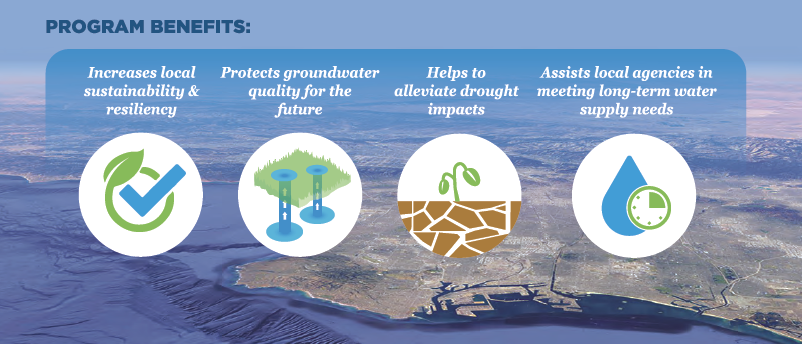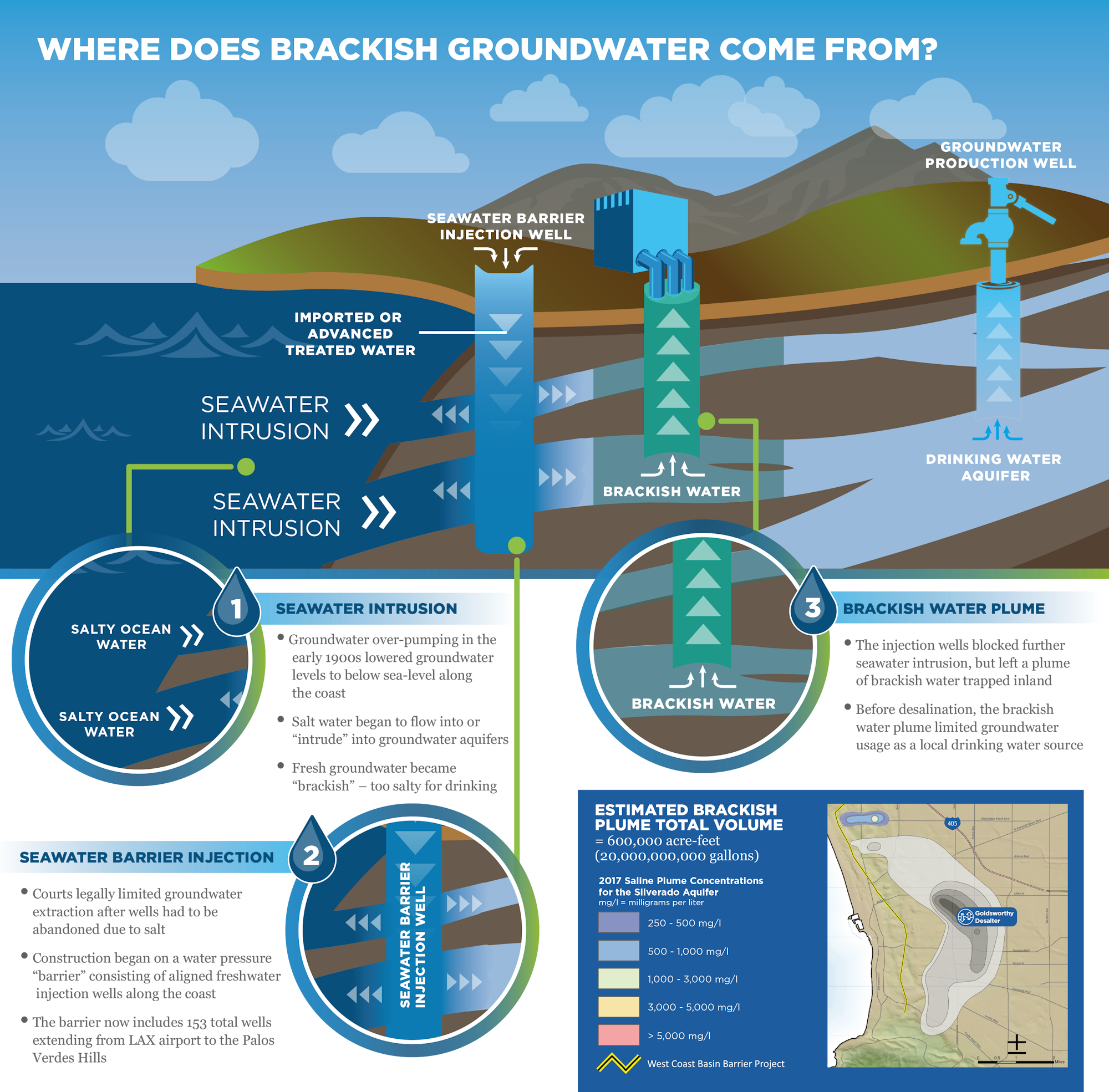Brackish Groundwater Reclamation Program
EXPANDING LOCAL WATER SUPPLY
The Brackish Groundwater Reclamation Program (BGRP) seeks to reclaim the historical brackish water plume in the West Coast Groundwater Basin and create a new local drinking water supply.
The Program will be comprised of multiple capital projects to desalt the brackish water plume. A critical step in achieving the objectives of BGRP is to expand WRD’s Torrance Groundwater Desalter facility. The expanded desalter facility will use new groundwater extraction wells, desalination, and state-of-the-art technology to purify the salty water and use it for distribution through local municipal drinking water systems. The Torrance Groundwater Desalter Expansion Project (TGDE) will use reverse osmosis to remove the salts from the water and will provide up to 7,100 acre-feet per year of additional high-quality drinking water to local water customers.
The removal of salty groundwater will in turn create available groundwater storage capacity for excess local freshwater and recycled water. Local water providers will be able to store surplus water for use during dry years—thus creating drought resiliency for generations to come.

THE HISTORY OF BRACKISH WATER IN THE GROUNDWATER BASINS
Groundwater over-pumping in the early 1900s lowered groundwater levels to below sea level along the coast (see the infographic below). This resulted in saltwater flowing into, or “intruding” into the groundwater aquifers. As the seawater mixed with the freshwater aquifers, the groundwater became “brackish,” or too salty for drinking.
Groundwater production wells in the West Coast Basin and in the southeastern tip of the Central Basin were affected, and water producers had to consider abandoning their wells.
In response, the courts legally limited groundwater extraction for the basins and LA County constructed seawater barrier injection wells starting in the early 1960s. The wells actively pump fresh water into the ground, thereby creating a water pressure “barrier” to keep seawater out of the aquifers. The Seawater Barrier system now consists of over 100 injection wells located along the coast and effectively protects the aquifers from seawater contamination.
While the Seawater Barrier system was an overall success, saving many wells, it trapped a plume of brackish groundwater inland from the barrier injection wells. This 14-square-mile plume still exists today, rendering groundwater pumping unfeasible in certain West Coast Basin areas.

TRIED AND TESTED
WRD’s experience in brackish groundwater reclamation started with the Robert W. Goldsworthy Desalter, located in the City of Torrance. The Goldsworthy Desalter was commissioned in 2001 and expanded in 2018. The facility now treats 3.6 million gallons per day (mgd) of salty groundwater extracted from the brackish plume in the West Coast Groundwater Basin using reverse osmosis technology. The plant is owned by WRD and operated by the City of Torrance. The treated water produced by this facility is added to the water distribution system for the City of Torrance and meets 25% of the city's water needs.
WRD, working in partnership with regional stakeholders will take the best practices and expertise from the Goldsworthy Desalter and apply them to the future Torrance Groundwater Expansion Project.
.jpg?ixlib=rb-1.1.0&w=2000&h=2000&fit=max&or=0&s=ed984b7ae8fe234b5c76dbe0a25d73ec)
HOW IS BRACKISH GROUNDWATER TREATED?
Groundwater desalination works primarily through the use of reverse osmosis treatment. Salty brackish groundwater extracted from wells is forced through reverse osmosis membranes to remove the salts in the water. The water is then disinfected and the pH level is adjusted to create fresh, potable water.

Program Next Steps
In 2021, WRD completed a Feasibility Study for the Program. Based on the Feasibility Study findings and stakeholder input, BGRP will include the Torrance Groundwater Desalter Expansion Project and potentially, a new desalter in Manhattan Beach to treat the northern portion of the brackish plume. A copy of the Final Feasibility Study and two follow-up addenda regarding project refinements and a new project site are available for download below.
Click here to download The Feasibility Study ReportClick here to download Addendum No. 1, Project Component RefinementsClick here to download Addendum No. 2, New Desalter Site AssessmentAfter the Feasibility Stud,y WRD completed Phase 1 of BGRP, a water quality testing and treatment system pilot program. The scope included:
- Installing small production wells and monitoring wells to evaluate aquifer water movement and water quality; and
- Piloting different treatment systems select the optimum treatment processes for the TGDE Project.
Phase 1 was completed in 2024 and was provided critical information to initiate Phase 2, the design and construction of the TGDE Project. The Project scope includes the construction of four new production wells, feedwater pipelines, and additional treatment capacity at the Robert W. Goldsworthy Desalter.
In April 2024, WRD selected McCarthy-Jacobs as the design-builder for the TGDE Project. WRD has implemented a progressive design-build delivery method for the TGDE Project. Using progressive design-build reduces the overall project duration by allowing some early elements of construction to begin while the design is finalized. The 90% design of the TGDE Project was completed in October 2025 and final design is expected in March 2026. Construction on feedwater pipelines is expected to begin November 2025.

